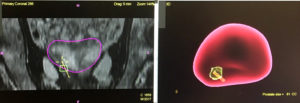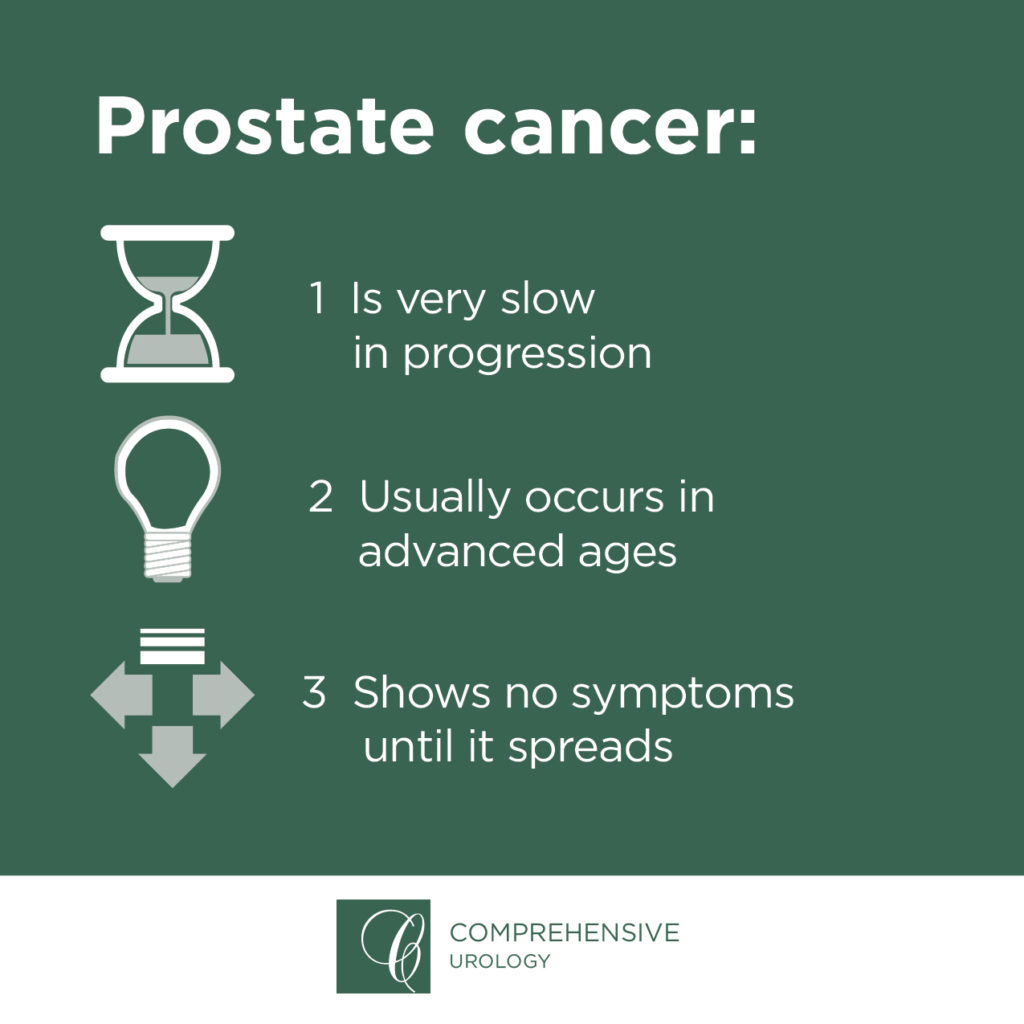Prostate Biopsy
After skin cancer, prostate cancer is the most common form of cancer among men. However, this disease can be curable when diagnosed in the early stages, making it critical that men be screened for the disease once they hit a certain age. With today’s technology and innovations, prostate cancer is a very treatable disease, but the first step starts with the patient choosing to undergo a screening.
With a collective experience of over 125 years, the urologists at Comprehensive Urology are equipped with the industry’s cutting-edge diagnostic and surgical tools. Whether obtaining a diagnosis for the first time or looking for a second opinion, our specialists can get faster and more accurate results than ever before. With new imaging techniques and highly refined, minimally invasive procedures, prostate cancer screenings and biopsies have come a long way in the last few decades, allowing us to offer men higher detection and survival rates and a better quality of life.
Prostate Cancer Screening Tests
Screening tests are available to help men identify prostate cancer in its early stages. Common prostate cancer tests include:
PSA (Prostate-Specific Antigen)
PSA testing is used to measure the level of PSA, a protein produced by normal and malignant prostate gland cells, in a man’s blood. Doctors frequently define a PSA level of 4 nanograms of PSA per milliliter of blood as normal. If a man’s PSA level exceeds 4 ng/mL, a doctor may recommend additional prostate cancer testing. However, in some studies, men who have a PSA level below 4 ng/mL have developed prostate cancer as well.
Digital Rectal Exam (DRE)
A DRE allows a doctor to evaluate a man’s lower rectum, pelvis, and lower belly. It is used to identify prostate cancer and other health problems, including blood in the stool or an abnormal mass in the rectum or anus.
Multiparametric MRI of Prostate
A multiparametric MRI of the prostate allows a doctor to visualize and examine the prostate’s anatomy. That way, a doctor can identify any prostate anomalies.
Genetic Tests (PCA3, ProPSA, 4K Score, etc.)
Studies have linked several genes and chromosomal regions to prostate cancer. If a patient’s parent, sibling, or other family members have experienced prostate cancer, genetic tests may be used to detect prostate cancer in its early stages. Several genetic testing options are available, and these include the prostate cancer antigen 3 gene (PCA3) and ProPSA tests.
Active Surveillance
In order to maintain a patient’s quality of life (and avoid over-treating patients), some patients with early-stage disease have been placed on active surveillance. Under active surveillance, patients are not treated immediately. Instead, they are monitored closely, and with repeat biopsies, the volume and aggressiveness of their prostate cancer is monitored. Prostate cancer treatment is then offered when a patient’s volume increases or if the aggressiveness of the prostate cancer worsens (or if the patient no longer wants to remain on active surveillance). At that time, either surgery or radiation therapy is provided to the entire prostate gland with the potential side effects as listed above (impotence, loss of urinary control, change in ejaculation, etc.).
Prostate Cancer Detection Biopsies
A prostate biopsy plays a major role in effective prostate cancer diagnosis and treatment. During a biopsy, a doctor will remove a small sample of tissue from the prostate and test it for cancer. A biopsy may be performed if an individual displays prostate cancer symptoms, and it may be completed in conjunction with other prostate cancer screenings as well.
Prostate Biopsy
A prostate biopsy generally requires only a few minutes to complete. At this time, a doctor inserts a needle into the wall of the rectum and extracts cells from the prostate for testing. A doctor collects multiple samples from different parts of the prostate as part of his or her evaluation.
Next, the prostate tissue samples will be sent to a laboratory and reviewed under a microscope. In most cases, a patient will receive the lab test results within a few days. If prostate cancer is identified, a patient will receive a Gleason score that indicates how quickly the cancer will grow and spread. The higher the Gleason score, the more likely it becomes that prostate cancer will quickly grow and spread.
MRI Fusion Prostate Biopsies
 Prostate cancer is a disease that has many treatment methods, but patients must be very careful when selecting a treatment option that is suitable for them. Many factors go into deciding the proper form of therapy, including a patient’s age, the extent of his cancer, its level of aggression, and more.
Prostate cancer is a disease that has many treatment methods, but patients must be very careful when selecting a treatment option that is suitable for them. Many factors go into deciding the proper form of therapy, including a patient’s age, the extent of his cancer, its level of aggression, and more.
Before determining a treatment method, patients need to ensure that their cancer is properly identified and diagnosed. MRI fusion targeted biopsies are a new procedure that can easily identify men who should be treated for prostate cancer.
How MRI Targeted Biopsies Work
An MRI targeted biopsy removes all the guesswork present in traditional biopsies. During an MRI targeted biopsy, prostate cancer specialists use MRI (magnetic resonance imaging) and ultrasound images together to be more comprehensive and accurate than traditional biopsy measures.
When performing an MRI targeted biopsy, specialists use magnetic resonance imaging to create a 3D image of a patient’s prostate. This image is then superimposed onto the live ultrasound image, allowing the specialists to better identify targets and differentiate them from normal, healthy cells. A needle is inserted directly into the marked (and likely cancerous) region of the prostate (no guesswork is required) and tissue samples are taken from the gland.
MRI targeted biopsies have made prostate cancer identification much more accurate and comprehensive. Prior to the advent of target biopsies, an estimated 38% of cancer cases were misidentified by traditional biopsy procedures. Since prostate cancer is best treated early, proper identification is incredibly important when treating the disease.
Comfortable Prostate Biopsies
A prostate biopsy may be performed using sedation and local anesthetic, and using MRI targeting. This often results in a much more comfortable experience with no pain for patients in comparison to other prostate biopsy options.
Ultrasound vs MRI Fusion For Prostate Cancer Detection
Traditionally, a urologist performs a prostate biopsy through the use of an ultrasound probe into the patient’s rectum. As the prostate is found in front of the rectum, this allows the prostate to be seen and evaluated during the procedure. With the guidance of the ultrasound images, tissue samples can be taken from different locations in the prostate (i.e. prostate biopsy).
While this techniques provides some degree of guidance for the urologist to obtain biopsy samples, it is far from perfect. In fact, the most important advances in prostate biopsies have been through consistently improving imaging technology. Multi-parametric MRI imaging advancements that are tuned specifically towards detecting abnormalities in the prostate gland now allow our team at Comprehensive Urology to identify many prostate cancers with unprecedented accuracy.

During an actual prostate biopsy, live ultrasound imaging (not MRI) is used to guide the urologist. The difficulty to date has been how to simultaneously provide the information from an MRI test to the urologist who is performing the biopsy using a rectal ultrasound device as the guide.
Advances in medical imaging technology now allow us to use the MRI images (obtained prior to the biopsy day) and overlay them on the ultrasound images in real time (i.e. MRI ultrasound fusion biopsy or simply “MR Fusion” Biopsy). That means that we are able to use the MRI as a real-time map when doing an ultrasound evaluation of the prostate. We are therefore no longer performing relatively blind biopsies, but in fact are able to have very targeted, precise prostate sampling.
This technological advance has been revolutionary. At the time of the biopsy, we can now see the suspected lesions and accurately biopsy them. This leads to more precise diagnoses and fewer repeat biopsies for patients.
The following are some examples of how an ultrasound biopsy can easily miss significant prostate cancers:
- By missing the actual mass of the cancer and only hitting the side of the cancer, doctors can be fooled into believing that the cancer is quite small when in reality it is quite sizable and potentially life-threatening.
- Depending on the location of the prostate cancer or the size of the cancer, an unguided biopsy can miss the cancer altogether. In this situation, a patient is erroneously told that they are cancer-free while there is a dangerous cancer unknowingly growing in their prostate. These lesions will typically be present in a much more advanced stage where the overall prognosis for the patient can now be quite limited. The importance of an MRI fusion biopsy cannot be overstated.
Preparing for Your Prostate Biopsy: What to Expect
A urologist dedicates time and resources to prepare a patient for a prostate biopsy. He or she outlines all prostate biopsy steps, as well as responds to a patient’s concerns and questions. In some instances, a urologist asks a patient to take an enema the day of the procedure, too.
Patients should provide a urologist with details about their current medications before a prostate biopsy. Sometimes, patients will need to temporarily stop taking blood thinners, aspirin, or other medications prior to a prostate biopsy.
During a prostate biopsy, an ultrasound probe is inserted into a patient’s rectum. The probe provides an image of the prostate gland. Next, tissue samples are removed from the prostate via a tiny needle. Multiple samples are collected, and they reviewed at a laboratory under a microscope after a prostate biopsy.
A prostate biopsy typically requires about 20 to 30 minutes to complete. Patients sometimes feel mild discomfort following a prostate biopsy. They may also receive an antibiotic to help reduce the risk of infection.
In certain instances, patients may experience one or more of the following side effects after a prostate biopsy:
- Rectal bleeding
- Blood in semen
- Blood in stool or urine
- Difficulty urinating
- Urinary incontinence
Prostate biopsy results are usually available within a few days of the procedure. A positive prostate biopsy indicates that prostate cancer is present. A positive prostate biopsy report highlights the location of cancer cells in the prostate, along with the extent and location of the cancer. It also helps a urologist determine the best way to treat the cancer.
If a patient’s prostate biopsy results come back negative, no cancer cells were discovered during the examination. Yet negative prostate biopsy results do not necessarily guarantee that a patient is cancer-free. For example, if cancer cells are located outside an area that was not sampled during the biopsy, a false-negative may occur.
A urologist may recommend additional testing if a patient’s PSA levels are high, despite the fact that his prostate biopsy results were negative. Or, a urologist may request a second prostate biopsy.
FAQs
What are the types of prostate biopsies?
There are four types of prostate biopsies: transrectal ultrasound-guided, transurethral, transperineal, and MRI-guided procedures. The ideal prostate biopsy varies based on the patient, and a urologist will perform a full patient evaluation to determine which option can deliver the optimal results.
How painful is a prostate biopsy?
A prostate biopsy probe may cause minor pain after it is inserted into the rectum. However, the probe is roughly the size of a pencil, and most patients report little to no discomfort or pressure during a prostate biopsy. Meanwhile, some patients experience a slight burning sensation after anesthetic is applied during a prostate biopsy, and this sensation is usually followed by numbness.
When do I need a biopsy?
A doctor may request a prostate biopsy if a patient has trouble urinating, difficulty getting or maintaining an erection, or displays other prostate cancer symptoms. Also, a doctor may request a prostate biopsy if a patient’s blood test shows that he is dealing with high PSA levels.
Are there prostate biopsy alternatives?
A digital rectal exam (DRE) or ultrasound may be used in lieu of a prostate biopsy. During a DRE, a urologist inserts a finger into a patient’s rectum and feels the prostate. This allows a urologist to feel for bumps and determine if the prostate is enlarged. Comparatively, during an ultrasound, a urologist inserts a small probe into the rectum. This enables a urologist to take photos of a patient’s prostate. Other prostate biopsy alternatives are also available, and these include free PSA and urine tests.
Contact a Prostate Cancer Specialist Today
If you have any additional questions about prostate cancer screening and diagnosis, or if you would like to schedule a consultation, please contact Comprehensive Urology today. Our urological specialists are experts in their field and have treated over 100,000 patients from all around the world. As pioneers of robotic and minimally invasive prostate cancer surgeries, you can rest assured that you’re in the best hands possible when visiting our center.
Schedule a Prostate Cancer Test with Our Expert Urologists Today
Comprehensive Urology employs expert urologists who perform prostate cancer tests and provide a variety of prostate cancer treatments. To schedule a prostate cancer screening, please contact us today at (310) 499-2756.
